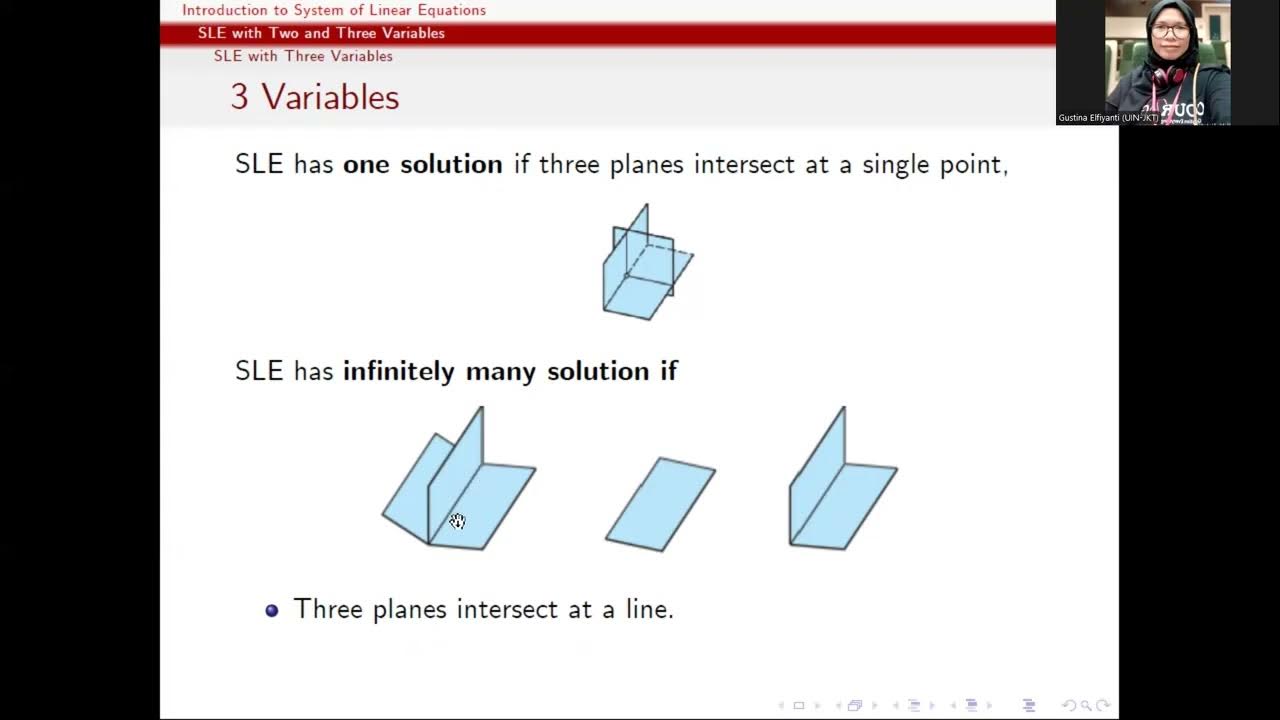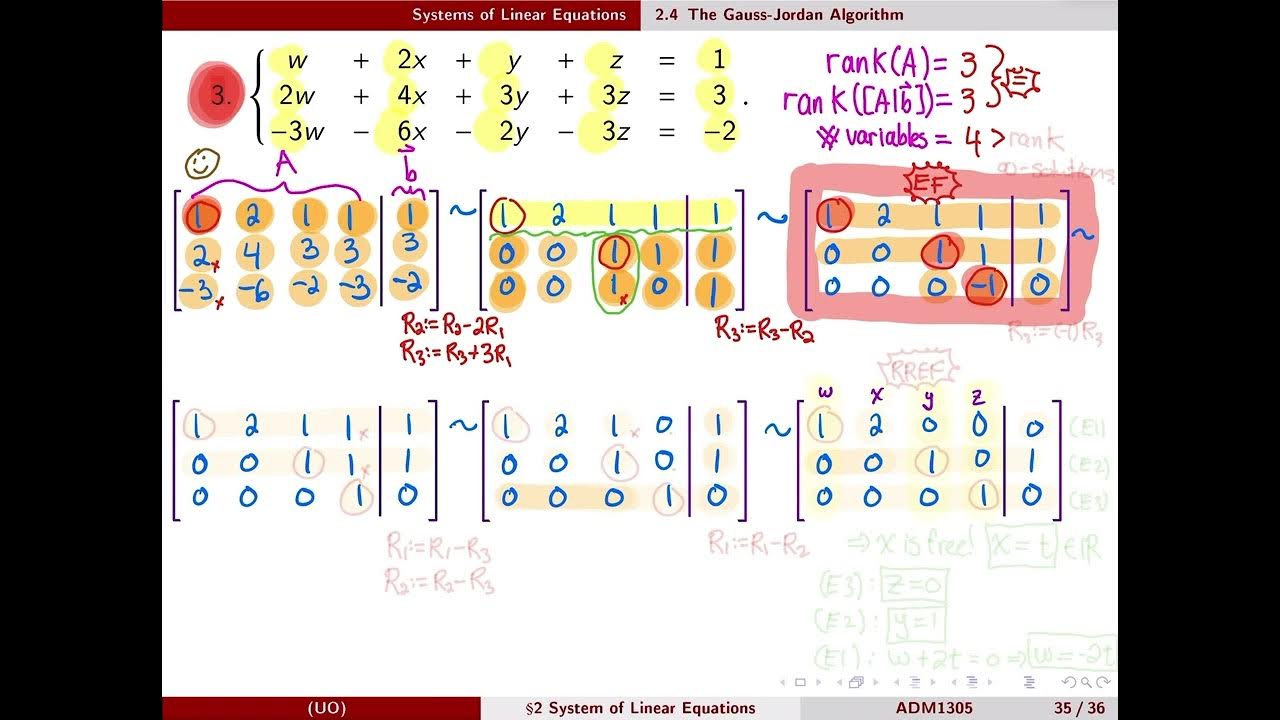Aljabar Linear: Matriks Eselon Baris Tereduksi dan Matriks Eselon
Summary
TLDRThis video provides a comprehensive explanation of the reduced row echelon matrix (RREF) and row echelon matrix (REF), outlining the four key criteria for a matrix to meet RREF conditions. It explains the importance of row headers, the arrangement of non-zero entries, and the placement of zero rows. Through examples, the script highlights how the row headers should form a ladder-like structure and how each column with a row header should have all other entries as zero. The video also compares matrices that meet or fail to meet RREF conditions, providing a clear and thorough understanding of the topic.
Takeaways
- 😀 A reduced row echelon matrix must satisfy four key conditions: 1) At least one non-zero entry in each row, 2) The first non-zero entry in each row must be 1, 3) The leading 1 in each row must be to the right of the leading 1 in the row above it, 4) Columns containing a leading 1 must have zeros everywhere else in that column.
- 😀 A row head in a reduced row echelon matrix must be the first non-zero number in its row, and must be 1.
- 😀 If a row is entirely zeros, it should appear at the bottom of the matrix.
- 😀 Consecutive non-zero rows in a matrix should be arranged in a way that the leading 1's form a 'ladder-like' structure.
- 😀 A column containing a leading 1 must have all other elements in that column equal to 0.
- 😀 The number of rows and columns in a matrix does not need to be equal for it to be a reduced row echelon matrix.
- 😀 A reduced row echelon matrix can be non-square, and its order is flexible.
- 😀 The row echelon matrix must fulfill the first three conditions of reduced row echelon matrix, but the fourth condition is stricter in ensuring that columns with leading 1's have all zeros except for the 1 itself.
- 😀 When evaluating whether a matrix is a reduced row echelon matrix, check if the matrix meets the four conditions: row heads (leading 1's), row arrangement resembling a ladder, and columns with zeros above and below the row heads.
- 😀 An identity matrix is an example of a reduced row echelon matrix because it satisfies all four conditions.
- 😀 If a matrix does not fulfill any of the four conditions (e.g., columns with non-zero elements above or below a row head), it is not a reduced row echelon matrix.
Q & A
What are the four main criteria for a matrix to be in reduced row echelon form?
-The four main criteria are: 1) Each row must have at least one non-zero entry, 2) The first non-zero entry in each row must be 1, 3) The row head must resemble a ladder pattern, where each row header (1) moves further to the right in subsequent rows, and 4) In any column containing a row header, all other elements in that column must be zero.
What is the significance of the first non-zero element in each row?
-The first non-zero element in each row must be 1 and is called the row head. This is crucial for the matrix to meet the reduced row echelon form criteria.
What should be done if a row in the matrix consists entirely of zero entries?
-If a row consists entirely of zeros, it should be placed at the bottom of the matrix.
How does the row header arrangement resemble a ladder in the reduced row echelon form?
-The row header arrangement resembles a ladder in that the position of the row headers (the first non-zero element in each row) must move progressively to the right as you move down the rows.
What happens to the columns that contain row headers in reduced row echelon form?
-In a column containing a row header, all other entries must be zero, except for the entry corresponding to the row header itself, which must be 1.
Can a matrix in reduced row echelon form have any rows of zeros?
-Yes, a matrix in reduced row echelon form can have rows of zeros, but they must be positioned at the bottom of the matrix.
What is the difference between a row echelon matrix and a reduced row echelon matrix?
-A row echelon matrix meets the first three criteria of a reduced row echelon matrix but does not necessarily satisfy the fourth criterion. A reduced row echelon matrix fulfills all four criteria, including that all entries above and below a row header must be zero.
What happens if the fourth condition for reduced row echelon form is not met?
-If the fourth condition is not met, the matrix is not in reduced row echelon form. This could occur if any column containing a row header has non-zero entries above or below the row header.
Is it necessary for a matrix to be square in order to be in reduced row echelon form?
-No, a matrix does not need to be square to be in reduced row echelon form. The size of the matrix does not affect the application of the four criteria.
What is an example of a matrix that is in reduced row echelon form?
-An example of a reduced row echelon form is the identity matrix. In this case, each row has a row header of 1, and all elements in the columns containing a row header are zero except for the row header itself.
Outlines

This section is available to paid users only. Please upgrade to access this part.
Upgrade NowMindmap

This section is available to paid users only. Please upgrade to access this part.
Upgrade NowKeywords

This section is available to paid users only. Please upgrade to access this part.
Upgrade NowHighlights

This section is available to paid users only. Please upgrade to access this part.
Upgrade NowTranscripts

This section is available to paid users only. Please upgrade to access this part.
Upgrade NowBrowse More Related Video

Row Echelon Form of the Matrix Explained | Linear Algebra

Introduction to SLE

Gauss-Jordan Elimination

SERI KULIAH ALJABAR LINEAR ELEMENTER || IMPLEMENTASI GAUSS JORDAN PADA MASALAH COMPUTER SCIENCE

MATRIKS RUANG VEKTOR | OPERASI BARIS ELEMENTER (OBE), MATRIKS ESELON BARIS TEREDUKSI

ADM1305 - Section 2.4 (Part 3)
5.0 / 5 (0 votes)